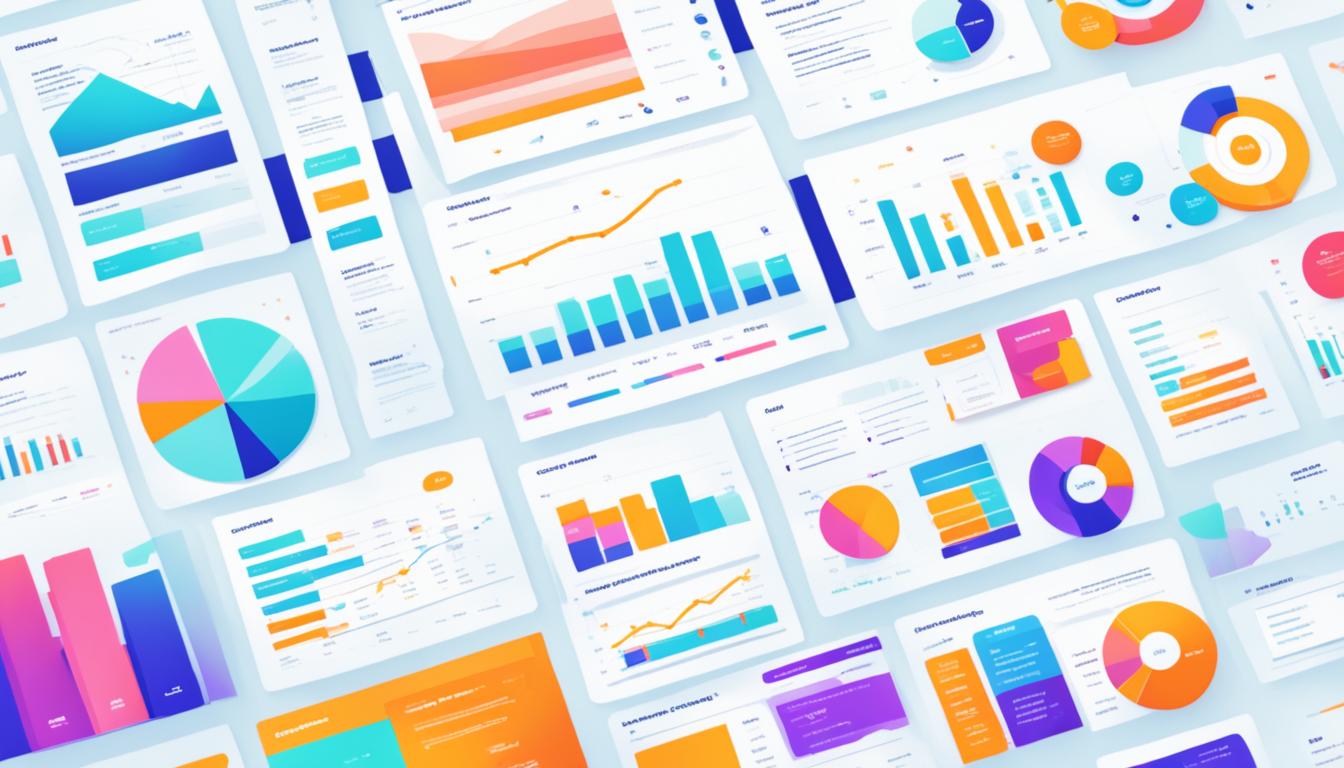Improve your return on ad spend with first-party data and unlock the potential of data-driven ad campaigns. In the world of programmatic advertising, where data privacy restrictions and legislation shape the landscape, leveraging first-party data has become essential for ad spend optimization.
Programmatic advertising, accounting for over 90% of all display advertising transactions, offers great flexibility and control over ad spending. However, the reliance on third-party data and cookies puts advertisers at risk of data deprecation and limits the effectiveness of targeting and ad performance.
A first-party data and customer context solution added to your MarTech stack can mitigate the negative impacts of data deprecation. By utilizing first-party data equivalents, gaining data analysis capabilities, and obtaining ad effectiveness insights, you can optimize your ad campaigns and drive better results.
Key Takeaways:
- First-party data is crucial for improving return on ad spend.
- Programmatic advertising relies heavily on third-party data and cookies.
- Adding a first-party data solution to your MarTech stack can provide benefits such as data analysis capabilities and ad effectiveness insights.
- Optimizing ad campaigns with first-party data equivalents can lead to better results.
- Data deprecation risks can be mitigated by leveraging first-party data.
How Does Programmatic Advertising Work?
Programmatic advertising is a data-driven approach to digital advertising that utilizes AI and machine learning algorithms to automate the buying, selling, and placement of ads. This advanced technology revolutionizes the ad campaign process, allowing advertisers to reach their target audience more effectively and optimize their ad spend for maximum ROI.
When a user visits a website or app, programmatic advertising platforms collect and analyze real-time data about the user, such as their demographics, behavior, and interests. Advertisers define their targeting criteria, including attributes like location, age, and browsing history. Based on these criteria, the programmatic platform selects the most relevant ad inventory in real-time and displays the ad to the user.
One of the key features of programmatic advertising is that advertisers only pay for impressions that meet their targeting criteria, ensuring that their budget is spent efficiently. This means that ads are not wasted on irrelevant audiences, increasing the chances of conversions and maximizing the impact of ad campaigns.
“Programmatic advertising automates the buying, selling, and placing of digital ads using AI and machine learning.”
While programmatic advertising offers numerous advantages, it heavily relies on cookies to track user activity and deliver personalized ads. However, with increasing privacy concerns and regulations like GDPR and CCPA, third-party cookies face limitations, affecting the accuracy of ad targeting and performance.
As the landscape evolves, advertisers need to adapt and explore alternative solutions, such as leveraging first-party data and customer data platforms (CDPs), to maintain the effectiveness of programmatic advertising.
Now, let’s take a closer look at the programmatic advertising process:
| Step | Description |
|---|---|
| 1 | Visitor arrives on a website or app |
| 2 | Real-time data is collected about the visitor |
| 3 | Advertiser’s targeting criteria are applied |
| 4 | Programmatic platform selects the most relevant ad inventory |
| 5 | Ad is displayed to the visitor |
Programmatic advertising allows advertisers to reach their target audience with precision and efficiency. By leveraging data-driven insights and automation, advertisers can optimize their ad campaigns and achieve better results.
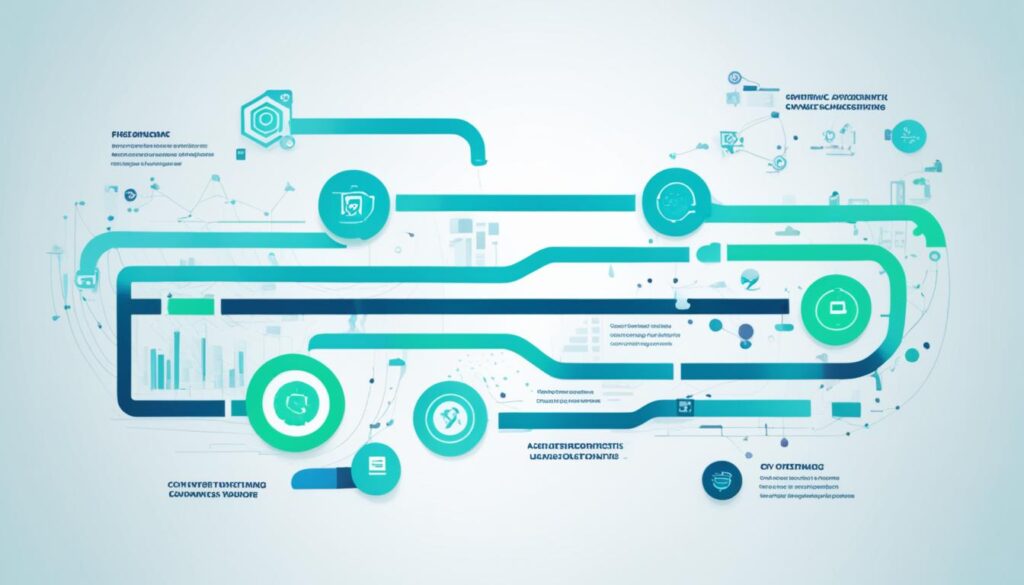
Why Do You Need a CDP for Programmatic Advertising?
Programmatic advertising has become a vital component of digital marketing strategies. However, recent data deprecation measures and the limitations on third-party data access have posed challenges for programmatic ad platforms to deliver effective and targeted campaigns. This is where a customer data platform (CDP) comes in.
A CDP plays a crucial role in helping marketers optimize their programmatic advertising efforts by leveraging first-party data effectively. It provides a comprehensive view of customer identity and interactions, connecting all data points across devices, domains, channels, and time. Through advanced AI and machine learning capabilities, a CDP delivers contextualized data that enhances ad targeting, triggers, and performance.
By combining first-party data with other datasets, a CDP fills the gaps left by the deprecation of third-party data. Marketers can gain deeper insights into their target audiences and create highly personalized campaigns. Let’s take a closer look at the specific benefits of using a CDP for programmatic advertising:
- Enhanced Data Quality: A CDP ensures the accuracy and reliability of first-party data by centralizing and unifying customer information from various touchpoints. This eliminates data silos and improves the overall quality of the data used for ad targeting and optimization.
- Improved Ad Targeting: Leveraging first-party data through a CDP allows marketers to target their ads with precision. By understanding customer behaviors, preferences, and purchase history, programmatic ad platforms can deliver ads that resonate with individual users, increasing the chances of conversions and engagement.
- Elimination of Third-Party Cookie Reliance: With the deprecation of third-party cookies, relying solely on programmatic ad platforms becomes inefficient. A CDP enables marketers to gather and utilize first-party data to customize and optimize their ad campaigns without depending on third-party cookies.
Using a customer data platform alongside programmatic advertising ensures that advertisers have access to up-to-date and relevant customer information, enabling them to deliver targeted, personalized, and impactful campaigns.
A customer data platform adds a layer of intelligence to programmatic advertising, enabling marketers to overcome the challenges posed by data deprecation. With its enhanced data quality, improved targeting capabilities, and independence from third-party cookies, a CDP empowers marketers to make more informed decisions and maximize the ROI of their programmatic advertising efforts.
CUSTOMER DATA PLATFORM IN ACTION
Let’s take a closer look at how a customer data platform can enhance the effectiveness of programmatic advertising:
| Programmatic Advertising without a CDP | Programmatic Advertising with a CDP |
|---|---|
| Reliance on third-party data for ad targeting | Combines first-party data with AI-driven insights to create highly targeted campaigns |
| Limited understanding of customer identity and interactions | Provides a comprehensive view of customer data across devices, domains, channels, and time |
| Less control over ad effectiveness and performance | Optimizes ad triggers and performance based on deep customer insights |
As seen in the table above, a customer data platform enhances programmatic advertising by offering a more data-driven and personalized approach. It empowers marketers to deliver highly targeted campaigns, gain a deeper understanding of their customers, and optimize ad triggers and performance.
Benefits of Programmatic Advertising Using First-Party Data
Programmatic advertising using first-party data offers numerous advantages for advertisers. By leveraging their own data, advertisers can enhance the performance and efficiency of their ad campaigns, ultimately leading to better results and increased return on investment (ROI).
More Cost-Efficient Ad Placement
One of the key benefits of utilizing first-party data in programmatic advertising is the ability to purchase more cost-efficient ad placements. With access to valuable insights about their target audience, advertisers can strategically place their ads where they are most likely to drive engagement and conversions. By targeting specific segments and leveraging real-time data, advertisers can optimize their ad placements to minimize costs while maximizing the reach and impact of their campaigns.
Increased Conversions by Targeting Relevant Audiences
First-party data enables advertisers to target their advertising campaigns to audiences that are most likely to convert. By utilizing data on customer behavior, preferences, and purchase history, advertisers can create personalized and highly relevant ad experiences for their target audience. This targeted approach leads to higher conversion rates and more meaningful interactions between consumers and brands.
Real-Time Adaptation and Optimization
Programmatic advertising using first-party data allows for real-time adaptation and optimization of ad campaigns. By continuously analyzing and leveraging real-time data, advertisers can quickly adjust their targeting strategies, creative elements, and ad placements to optimize performance. This real-time optimization ensures that ad campaigns are always aligned with the changing needs and behaviors of the target audience, maximizing the effectiveness of the advertising spend.
Improved Efficiency in Ad Campaign Management
First-party data provides advertisers with valuable insights into the performance of their ad campaigns, allowing for efficient management and decision-making. By tracking key performance metrics in real-time, advertisers can evaluate the success of their campaigns and make data-driven adjustments as needed. This level of visibility and control enables advertisers to allocate their resources effectively, ensuring that their ad spend is focused on the strategies and channels that drive the highest ROI.
Overall, programmatic advertising using first-party data empowers advertisers with data-driven insights and advanced targeting capabilities. By leveraging their own data, advertisers can optimize ad placements, increase conversions, adapt in real-time, and efficiently manage their ad campaigns, leading to improved outcomes and greater success.
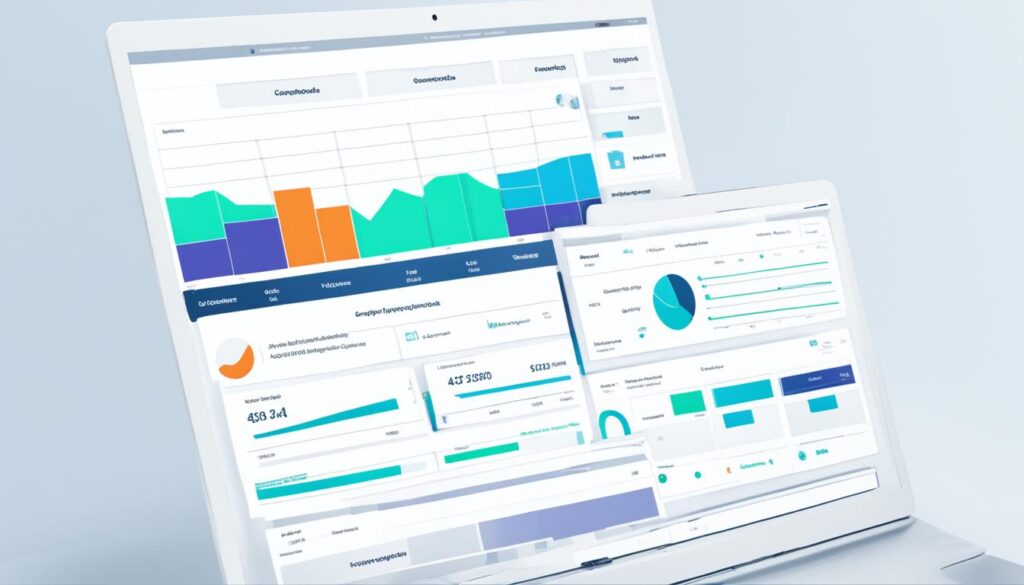
Leveraging Google Analytics 4 for First-Party Data
In today’s digital landscape, leveraging first-party data is essential for successful marketing campaigns. Google Analytics 4 (GA4) is a robust tool that empowers businesses to collect valuable customer insights, optimize strategies, and create targeted campaigns with accuracy and efficiency. With GA4, marketers can make informed decisions based on real-time data, maximize their marketing budget, and drive impressive results.
GA4 provides a comprehensive view of customer journeys, allowing businesses to understand their audience’s interaction with their website. By tracking key performance metrics such as page views, conversion rates, and bounce rates, businesses can optimize their strategies and tailor their campaigns to target the right audience segments. Through GA4, marketers gain deeper customer insights that help them make data-driven decisions and develop effective marketing strategies.
One of the key advantages of GA4 is its ability to help businesses rank higher in Google search results. By analyzing website data and user behavior, GA4 provides valuable information that can boost organic visibility and attract more qualified traffic. This enables businesses to increase their online presence and generate more leads without solely relying on paid advertisements.
Moreover, GA4 offers a clear view of customer journeys, allowing businesses to understand the entire buying process. This insight enables marketers to identify touchpoints where customers might drop off or encounter issues, allowing for optimization and enhanced user experiences. By optimizing customer journeys, businesses can improve conversion rates, increase sales, and maximize their ROI.
The key to successful marketing is understanding your customers. With Google Analytics 4, businesses can unlock valuable customer insights, optimize their marketing budget, and develop targeted campaigns that deliver outstanding results.
To illustrate the potential of leveraging GA4 for first-party data, here’s a table showcasing key features and benefits:
| Feature | Benefit |
|---|---|
| Comprehensive customer insights | Drive data-driven decision-making and improve targeting |
| Improved organic search visibility | Rank higher in Google search results and attract more qualified traffic |
| Optimized customer journeys | Increase conversion rates and maximize ROI |
By leveraging GA4, businesses can make the most of their marketing budget, targeting the right audience segments and improving campaign effectiveness. GA4’s powerful capabilities enable businesses to gain a competitive edge in today’s data-driven marketing landscape.
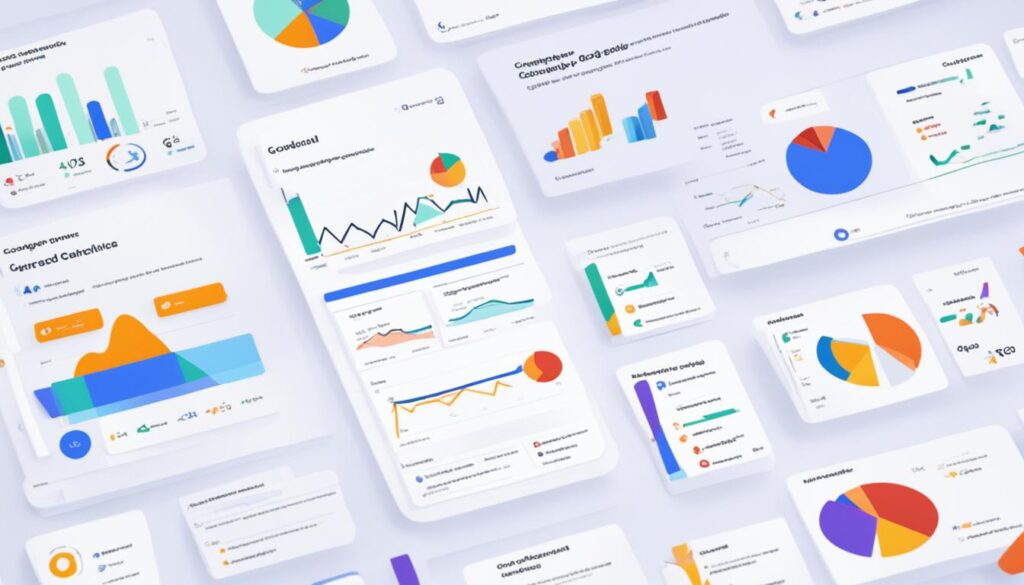
Customer Segmentation and Personalization with First-Party Data
In today’s highly competitive digital landscape, businesses strive to deliver personalized experiences and targeted messages to their customers. By leveraging customer segmentation with first-party data, companies can unlock the potential for tailored marketing strategies that resonate with their audience on a deeper level.
Customer segmentation is a powerful strategy that involves grouping customers based on similar profiles and behaviors. It enables businesses to understand their audience better, identify specific needs and preferences, and ultimately deliver personalized experiences that meet those expectations. With access to first-party data, companies can gain valuable insights into customer behavior, demographics, and interactions, allowing them to create more relevant and compelling messaging.
By utilizing first-party data, businesses can create targeted messages and promotions that speak directly to the unique preferences and interests of individual segments. Tailoring marketing communications based on customer segmentation not only improves customer satisfaction and engagement but also increases the likelihood of conversions and repeat purchases.
Behavioral segmentation takes personalization to the next level by delivering experiences that resonate with each audience segment. By analyzing customer behavior patterns, businesses can identify trends, preferences, and buying habits, enabling them to craft targeted messages that are highly effective in driving engagement and conversions. Whether it’s through personalized product recommendations, exclusive offers, or relevant content recommendations, behavioral segmentation ensures that customers receive the right message at the right time.
“Segmentation enables businesses to deliver personalized experiences, tailored messages, and promotions that resonate with individual audience segments.”
By embracing customer segmentation and personalization with first-party data, businesses can build stronger relationships with their customers. By creating tailored experiences and delivering targeted messages, companies can enhance customer communications and foster a deeper sense of connection and understanding. This, in turn, boosts customer loyalty, drives repeat purchases, and generates revenue opportunities for long-term success.
Benefits of Customer Segmentation and Personalization:
- Improved customer satisfaction through personalized experiences
- Increased customer engagement and brand loyalty
- Higher conversion rates and sales
- Enhanced marketing effectiveness and efficiency
- Better understanding of customer preferences and behaviors
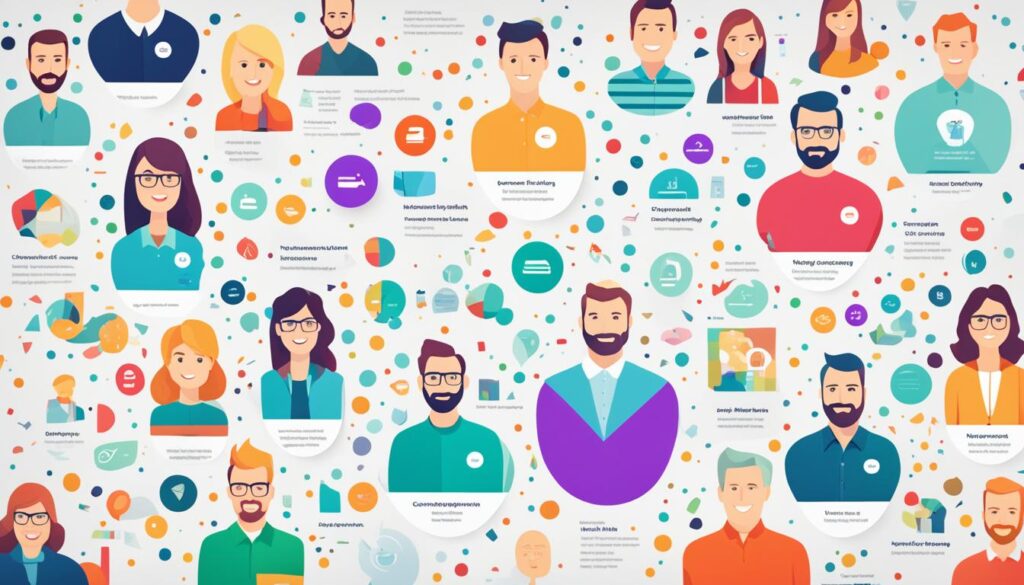
When businesses prioritize customer segmentation and personalization with first-party data, they can deliver relevant, targeted messages that resonate with their audience. By harnessing the power of first-party data, companies can unlock insights that allow them to create personalized experiences, build stronger relationships, and drive business growth.
Strengthening Customer Relationships with First-Party Data
In today’s digital landscape, effective customer communication is essential for businesses to build trust, tailor experiences, and understand buyer behavior. By leveraging first-party data, businesses can unlock valuable insights that enable personalized conversations and deliver relevant content to their customers.
First-party data allows businesses to gain a deeper understanding of their customers’ preferences, interests, and behaviors. By analyzing this data, businesses can identify customer intent, anticipate their needs, and engage in personalized conversations that resonate with them.
One effective way to utilize first-party data for customer communications is through personalized messaging. By using customer data to tailor messages according to individual preferences, businesses can create a closer connection with their customers. Personalized communication channels, such as text messages, allow for more intimate and direct conversations, fostering a sense of trust and loyalty.
“Personalized communication through first-party data enables businesses to build trust, gain customer understanding, and drive revenue growth.”
Furthermore, understanding buyer behavior is crucial for businesses to deliver relevant content and experiences. First-party data provides insights into the actions and interactions of customers, enabling businesses to align their offerings with their customers’ preferences and needs.
By leveraging first-party data, businesses can:
- Gain insights into customer preferences and interests
- Create targeted messaging and promotions
- Deliver personalized experiences
- Build trust and loyalty
Overall, by leveraging first-party data for customer communications, businesses can strengthen relationships, improve customer understanding, and capitalize on revenue growth opportunities.
Conclusion
In today’s data-driven marketing landscape, leveraging first-party data is essential for maximizing return on ad spend. By utilizing first-party data in programmatic advertising, businesses can benefit from cost-efficient ad placement, increased conversions through targeted audience engagement, real-time optimization, and improved campaign efficiency.
Tools like Google Analytics 4 and customer data platforms play a crucial role in enabling businesses to collect, analyze, and effectively utilize first-party data. With the valuable insights obtained from these tools, businesses can optimize their marketing strategies, create personalized experiences, and ultimately maximize their ROI.
By adopting a data-driven approach to marketing and harnessing the power of first-party data, businesses can achieve impressive results and drive revenue growth. It’s time to embrace the opportunities that first-party data offers and unlock its full potential in shaping successful marketing campaigns and building strong customer relationships.
FAQ
How does programmatic advertising work?
Programmatic advertising automates the buying, selling, and placing of digital ads using AI and machine learning. Ad space is purchased in real-time based on specific criteria triggered by a qualified visitor. This process increases flexibility and control over ad spending, as advertisers only pay for impressions that meet their targeting criteria.
Why do you need a CDP for programmatic advertising?
A Customer Data Platform (CDP) helps fill the gaps in data by providing a comprehensive view of customer identity and interactions. It connects all data points across devices, domains, channels, and time, delivering contextualized data using AI and machine learning. With a CDP, marketers can combine first-party data with other datasets, optimize ad targeting and triggers, and eliminate reliance on third-party cookies.
What are the benefits of programmatic advertising using first-party data?
Programmatic advertising using first-party data offers benefits such as more cost-efficient ad placement, increased conversions by targeting relevant audiences, real-time adaptation and optimization, and improved efficiency in ad campaign management. By leveraging first-party data, advertisers can purchase higher-quality ad spots, optimize campaigns based on audience behavior, and measure performance metrics in real-time for quick adjustments.
How can Google Analytics 4 be leveraged for first-party data?
Google Analytics 4 (GA4) is a powerful tool for leveraging first-party data. It allows businesses to collect valuable insights about their customers, track performance metrics, and create targeted campaigns with accuracy and efficiency. With GA4, businesses can rank higher in Google search results, optimize strategies based on website data, and gain a clear view of customer journeys. Utilizing GA4 helps businesses maximize their marketing budget and drive impressive results.
How does customer segmentation and personalization work with first-party data?
Customer segmentation is a powerful strategy for leveraging first-party data. It allows businesses to group customers based on similar profiles and behaviors, enabling personalized and targeted experiences. With first-party data, businesses can create tailored messages and promotions, improving customer communications and building stronger relationships. Behavioral segmentation further enhances personalization by delivering experiences that resonate with each audience, leading to increased engagement, loyalty, and revenue opportunities.
How can first-party data strengthen customer relationships?
First-party data helps businesses strengthen customer relationships by improving communications, creating personalized experiences, and providing relevant content. By leveraging first-party data, businesses can gain insights into buyer behavior, understand customer intent, and build trust. Personalized communication through channels like text messages creates a closer connection between the business and its customers, leading to better customer understanding, increased loyalty, and revenue growth opportunities.
What are the key benefits of using first-party data in programmatic advertising?
Using first-party data in programmatic advertising is crucial for improving return on ad spend. It offers benefits such as cost-efficient ad placement, increased conversions through targeting relevant audiences, real-time optimization, and improved efficiency. Leveraging tools like Google Analytics 4 and customer data platforms enables businesses to collect, analyze, and utilize first-party data effectively. By using first-party data, businesses can optimize their marketing strategies, create personalized experiences, and maximize their ROI. With the right approach to data-driven marketing, businesses can achieve impressive results and drive revenue growth.

